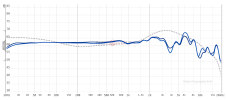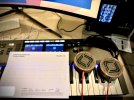Take all of what I've said or am about to say or leave it - for me, these drastic corrections are what makes headphone usable.
I should preface all of this by saying that I've always kind of hated headphones. It's
always been easier for me to get a sound I liked out of IEMs. All of the times when I've talked about being able to work on them, I say "headphones/IEMs" unless I just forget...and for me, I've
always actually meant IEMs. I guess I just assumed there was something different about my ears that made IEMs work and Headphones not. After spending the last few months pouring over the research....I'm no longer convinced that's the case.
For whatever reason, it seems like it's easier for designers to get close to one of the good targets with IEMs than with headphones.
FWIW, I am running a correction for my IEMs of choice that was also generated the same way. Level-matched (as precisely as I can do) blind comparisons come out with me preferring the correction literally 100% of the time. It's not ambiguous which I think is better. But, the correction for my IEMs is
much more mild...just a few bands and <3dB of change (most <1dB) except up at 17k (it's about a 6dB correction).
FWIW, IDK if I'd say I have "golden ears", but I can somehow still hear above 17k. I actually went to an audiologist+ENT last week for a follow-up from an ear infection a few weeks ago. The word "impeccable" came up.
If you think the 600s are painfully bright then we have different ears, which is often a reality person to person, or maybe you are driving them with something less common?
I honestly don't remember what I was using when I tried them last...I think that was while I had the RND headphone amp. But, yes, I returned them.
"Bright" is also just how I describe them in comparison. It's probably more accurate to say that they had no bass, and they end up painfully bright if you try to turn them up enough to hear any bass at all. All these EQ terms are relative. So, if you want to translate "painfully bright" to "no bass", it's at least as accurate.
11-12 db boosts? That is huge. Anything that needs that much frankly makes me wonder if something is broken or strangely configured... again from a distance.
Yeah, they are huge. I was honestly
shocked when I saw the suggested corrections, especially because I did it after trying sonarworks's corrections that were more reasonable (topping out at 3 or 4 dB, IIRC). The fact remains that apart from the obvious binaural vs stereo differences, they sound more like speakers or IEMs with that correction than without it or with less correction, and Sonarworks's correction did so little that it wasn't worth using.
I like sonarworks with the measurement mic just fine* for speakers in a room as a finishing touch after treatment, but I think it's
useless for headphones (I've also only tried the generic profiles and with 3-4 headphones, not a lot).
Note*: I wish you could limit the correction to only apply below about 300-500 Hz while using one of the well-established target curves instead of their "meh" default target. I'm pretty sure that I'm going to leave it behind and either do manual correction based on REW or buy a Trinnov this year some time.
I own the current gen LCD-X and they are very close to what my ears hear as flat without any tweaking, which is nice. With a very small amount of EQ, no more than 1-2db on any band, I can get them to truly dead flat, again for my ears as a reference.
A bunch of people have said that, but if you actually look at their measured response and compare it to either speakers measured by the same rig or any of the most strongly preferred targets derived from binaural measurements of speakers in a room (Harman OE 2018, tilted/shelved diffuse filed, etc.)...they're nowhere near right. I took it on faith that the drastic corrections were at least worth trying after reading quite a bit of Harman's published research. And, it was a night & day difference for me.
Here's one measurment ofthe LCD-X 2021 vegan pads (blue) vs Harman Over-Ear 2018 (dotted grey). I'm not sure which rig it was measured on, so I wouldn't take it as the "gospel truth", but most of the measurements of them that I've seen are at least similar.

I've demo'd Audeze cans in the past (can't remember which models, I think I paid around $1500ish for them several years ago) and they were nowhere near what I wanted to hear. What I remember isn't too far off from that graph. If you look at 4k, 10k, and 18k-ish those are all ~10-15 dB deviations.
Fortunately, there's hifi store not too far from me that has several high-end headphones available for demo. Some time soon, I'm going to go ahead and print my reference tracks through corrections for each model I want to try and go listen to them. I guess I might as well listen without correction as well, but...I don't have any expectations of liking any of them without correction.
But the mixes I've done with them, seem they translate just fine to my monitors as well, so...maybe the Kali Audio LP6 V2's are on the dark side too? I don't know...
I have no doubt that you (or almost anyone) can get used to them and put out mixes that translate - it's absolutely true that you have to know your monitoring more than your monitoring has to be perfect. A lot of people have been doing that for a long time. But....it seems like doing it that way is just making it harder on yourself.
I'm not sure I'd call Kalis dark based on the ones I've heard, but I'm not a fan. YMMV, obviously, and I haven't heard that specific model.


